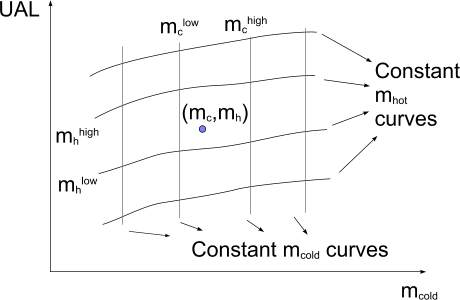Actual Method
Application of local heat exchanger energy sources into the hot/cold energy equations
At every solver iteration, the following steps are carried out to include the actual flow dual stream heat exchanger sources into the energy equations of the hot and cold fluid streams:
- Solver computes the UAL Table.
- For every cell
, the mass flux entering the cell is first computed as:
where and are the density and magnitude of velocity of the cold stream entering the cell.
The mass flow rate for the inlet is computed as:
where is the total inlet area of the heat exchanger region through which the cold stream enters the heat exchanger. After computing , the method interpolates the UAL table to determine the local cell corresponding to this value of .
- For every cell
of the heat exchanger region, the UAL Table is linearly interpolated to compute the local heat transfer coefficient
, given the cold and hot mass flow rates that are entering cell
If the local mass flow rate falls below the lowest mass flow rate in the table, then the local UAL is extrapolated as:
where is the entry in the UAL table corresponding to .
If the local mass flow rate exceeds the highest mass flow rate in the table , then , where is the entry in the UAL table corresponding to .
- The local energy source is computed as:
where:
- and are the temperatures of the hot and cold streams in cell
- is the volume of cell
- is the total number of cells in the heat exchanger region
- Apply as an energy source to the cold stream energy equation and as an energy sink to the hot stream energy equation.
Computation of the UAL Table
For each entry of the user input table (UAG Table, Q Table, or Q Map), a corresponding UAL value is computed, thus generating the UAL Table.
The UAL value is computed using the following expression:
where
When a UAG Table is supplied:
where:
is the user-table value, and , hot or cold, is the inlet temperature for the hot or cold streams, either area averaged or mass-flow averaged over the inlet interface boundary. The summation is over all the cell faces.
- Area averaged:(234)
and are the cell face values of temperature and surface area.
- Mass flow averaged:(235)
and are the cell face values of density and velocity.
When a Q Table or a Q Map is supplied:
where:
is the user-table value,
and are the user-supplied test rig inlet temperature values of the hot and cold streams respectively (these values are specified in Simcenter STAR-CCM+ as properties of Q Table or Q Map).
is the volume averaged temperature difference between the hot and cold streams, over the exchanger region.
Q Map Option
The Q Map option of the Actual Flow Dual Stream heat exchanger model uses bilinear interpolation to compute UAL values from an UAL map. Consider the graphical representation of a computed UAL map:

The points of intersection between the constant and represent data in the computed UAL map. The UAL at a general point is given by:
where
and
, , and are the UAL values at points , , , and , respectively.
For example, consider the following UAL table for a given Q Map table:
| mcold | mhot | UAL |
|---|---|---|
| 1.0 | 4.0 | 10.0 |
| 2.0 | 4.0 | 20.0 |
| 1.0 | 8.0 | 30.0 |
| 2.0 | 8.0 | 40.0 |
The UAL for a cold mass flow rate of 1.5 kg/s and a hot mass flow rate of 5.0 kg/s is computed as:
| mcold | mhot | UAL |
|---|---|---|
| 1.01 | 4.01 | 10.0 |
| 1.99 | 4.0 | 20.0 |
| 0.98 | 8.02 | 30.0 |
| 2.0 | 8.0 | 40.0 |